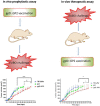Bacteriophages as Solid Tumor Theragnostic Agents
- PMID: 35008840
- PMCID: PMC8745063
- DOI: 10.3390/ijms23010402
Bacteriophages as Solid Tumor Theragnostic Agents
Abstract
Cancer, especially the solid tumor sub-set, poses considerable challenges to modern medicine owing to the unique physiological characteristics and substantial variations in each tumor's microenvironmental niche fingerprints. Though there are many treatment methods available to treat solid tumors, still a considerable loss of life happens, due to the limitation of treatment options and the outcomes of ineffective treatments. Cancer cells evolve with chemo- or radiation-treatment strategies and later show adaptive behavior, leading to failed treatment. These challenges demand tailored and individually apt personalized treatment methods. Bacteriophages (or phages) and phage-based theragnostic vectors are gaining attention in the field of modern cancer medicine, beyond their bactericidal ability. With the invention of the latest techniques to fine-tune phages, such as in the field of genetic engineering, synthetic assembly methods, phage display, and chemical modifications, noteworthy progress in phage vector research for safe cancer application has been realized, including use in pre-clinical studies. Herein, we discuss the distinct fingerprints of solid tumor physiology and the potential for bacteriophage vectors to exploit specific tumor features for improvised tumor theragnostic applications.
Keywords: bacteriophages; theragnostics; tumor.
Conflict of interest statement
The authors declare no conflict of interest.
Figures




Similar articles
-
Recent Advances and Mechanisms of Phage-Based Therapies in Cancer Treatment.Int J Mol Sci. 2024 Sep 14;25(18):9938. doi: 10.3390/ijms25189938. Int J Mol Sci. 2024. PMID: 39337427 Free PMC article. Review.
-
Interactions of Bacteriophages with Animal and Human Organisms-Safety Issues in the Light of Phage Therapy.Int J Mol Sci. 2021 Aug 19;22(16):8937. doi: 10.3390/ijms22168937. Int J Mol Sci. 2021. PMID: 34445641 Free PMC article. Review.
-
Flagellotropic Bacteriophages: Opportunities and Challenges for Antimicrobial Applications.Int J Mol Sci. 2022 Jun 25;23(13):7084. doi: 10.3390/ijms23137084. Int J Mol Sci. 2022. PMID: 35806089 Free PMC article. Review.
-
Phage-based vaccines.Adv Drug Deliv Rev. 2019 May;145:40-56. doi: 10.1016/j.addr.2018.12.013. Epub 2018 Dec 27. Adv Drug Deliv Rev. 2019. PMID: 30594492 Review.
-
A simple solid media assay for detection of synergy between bacteriophages and antibiotics.Microbiol Spectr. 2024 May 2;12(5):e0322123. doi: 10.1128/spectrum.03221-23. Epub 2024 Mar 25. Microbiol Spectr. 2024. PMID: 38526142 Free PMC article.
Cited by
-
Implication of the Gut Microbiome and Microbial-Derived Metabolites in Immune-Related Adverse Events: Emergence of Novel Biomarkers for Cancer Immunotherapy.Int J Mol Sci. 2023 Feb 1;24(3):2769. doi: 10.3390/ijms24032769. Int J Mol Sci. 2023. PMID: 36769093 Free PMC article. Review.
-
Pathogenesis and therapy of radiation enteritis with gut microbiota.Front Pharmacol. 2023 Mar 31;14:1116558. doi: 10.3389/fphar.2023.1116558. eCollection 2023. Front Pharmacol. 2023. PMID: 37063268 Free PMC article. Review.
-
Supramolecular nanotherapeutics based on cucurbiturils.J Nanobiotechnology. 2024 Dec 23;22(1):790. doi: 10.1186/s12951-024-03024-z. J Nanobiotechnology. 2024. PMID: 39710716 Free PMC article. Review.
-
Joining Forces: The Combined Application of Therapeutic Viruses and Nanomaterials in Cancer Therapy.Molecules. 2023 Nov 20;28(22):7679. doi: 10.3390/molecules28227679. Molecules. 2023. PMID: 38005401 Free PMC article. Review.
-
Emulating interactions between microorganisms and tumor microenvironment to develop cancer theranostics.Theranostics. 2022 Mar 14;12(6):2833-2859. doi: 10.7150/thno.70719. eCollection 2022. Theranostics. 2022. PMID: 35401838 Free PMC article. Review.
References
-
- Razazan A., Nicastro J., Slavcev R., Barati N., Arab A., Mosaffa F., Jaafari M.R., Behravan J. Lambda bacteriophage nanoparticles displaying GP2, a HER2/neu derived peptide, induce prophylactic and therapeutic activities against TUBO tumor model in mice. Sci. Rep. 2019;9:2221. doi: 10.1038/s41598-018-38371-z. - DOI - PMC - PubMed
-
- Global Cancer Facts & Figures. [(accessed on 20 July 2021)]. Available online: https://www.cancer.org/research/cancer-facts-statistics/global.html.
Publication types
MeSH terms
Substances
Grants and funding
LinkOut - more resources
Full Text Sources
Medical

